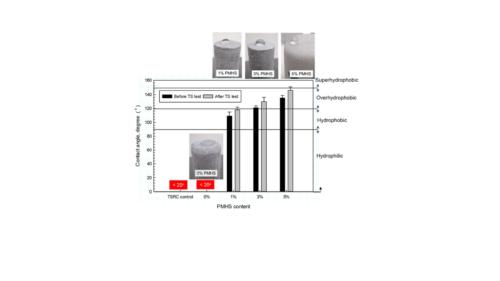Technologies Available for License
Category: energy
2020-012: Super-Hydrophobic, Thermally Insulating, Thermal-Shocks Resistant Well Cement
Invention: 2020-012
Patent Status: Application Number US 20220106516 A1 was published on April 7, 2022
For technical and licensing related questions, email tcp@bnl.gov.
Summary

Water contact angles for the control and 250 °C-autoclaved CAC samples containing 1, 3, and 5% PMHS-treated and untreated FCS before and after TS test.
There is a need for developing a lightweight, insulating well cement with adequate mechanical properties that can withstand frequent thermal shocks and chemically aggressive environments while providing sufficient tubular body support and metal corrosion protection. This invention provides a well cement composite and a method including a cementitious formulation, which, after the set under hydrothermal conditions, forms thermally insulating, thermal-shocks resistant well cement that can be used for filling the annular space between a tubular body and the wellbore to protect the well casing from long term exposure to geothermal fluids and temperatures.
Description
The cementitious formulations were achieved by using a combination of a cementitious material and fly ash cenospheres (FCS) with a water-repellant surface. The blend was water-mixable allowed preparation of slurries with rheological properties relevant for cementing subterranean wells. In addition to thermally insulating properties, after the set under the hydrothermal conditions, the blend developed desirable compressive strength and was thermal shock (TS) resistant. To obtain the water-repellant surface, the cenospheres (CS) were treated with a polysiloxane compound in an alkaline environment. The alkaline environment had a pH greater than 7. In the formulation most applicable for high-temperature geothermal wells, the blend is composed of calcium aluminate cement (CAC), and cenospheres with hydrophobic surfaces obtained by their pretreatment with polymethylhydrosiloxane (PMHS) in the presence of sodium metasilicate.
Benefits
This invention should potentially enable a decrease of energy losses during energy storage and recovery from geothermal wells while providing adequate well integrity.
Applications and Industries
The potential application area of this technology mainly includes geothermal cement for energy storage wells.
Journal Publication & Intellectual Property
Contacts
-

Poornima Upadhya
Manager Technology Transfer & Commercialization
Technology Commercialization
(631) 344-4711, pupadhya@bnl.gov
-

Avijit Sen
IP Licensing & Commercialization
Technology Commercialization
(631) 344-3752, asen@bnl.gov




